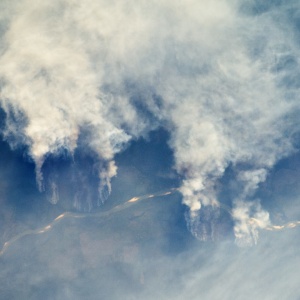
This piece examines the data behind forest fires in Brazil, which attracted international attention during the summer of 2019. It concludes that the number of fires in August 2019 was nearly three times higher than in August 2018, and that the extent of deforestation was the highest since 2008, thus refuting the Brazilian government’s claim that August 2019 was “normal” for deforestation. Some contributors to the piece declined to be listed as authors so that they could stay anonymous.
 Image: Figure 1b, Barlow et al. The grey bars show active fire counts; the yellow and orange lines show extent of deforestation. The 2019 readings are from a different detection system (DETER-b) to the previous readings (PRODES), as the 2019 figures are yet to be published for the PRODES system. Years with extreme droughts are shown with an asterisk.
Image: Figure 1b, Barlow et al. The grey bars show active fire counts; the yellow and orange lines show extent of deforestation. The 2019 readings are from a different detection system (DETER-b) to the previous readings (PRODES), as the 2019 figures are yet to be published for the PRODES system. Years with extreme droughts are shown with an asterisk.
In the figure above, the yellow line shows extent of deforestation from 1999 to 2018, based on the Brazilian PRODES system for measuring annual deforestation. Since the 2019 PRODES figures are not yet published, the 2019 extent of deforestation figures (orange) come from another measurement system, DETER‐b, and are adjusted using a standard conversion factor to account for the usual difference between PRODES and DETER-b readings.
The DETER-b system also detected a spike in monthly deforestation in July 2019 (red, below) of nearly four times the rate seen from 2016 to 2018 (blue, below). Deforestation declined, albeit to a level still well above the average, after a two-month ban on fires to clear land was announced by Brazilian President Bolsonaro.

Image: Figure 1c, Barlow et al. Monthly deforestation detected by DETER‐b for the period April–September, comparing 2019 (red) with the mean ± SD from 2016–2018 (blue). The vertical dashed line represents the onset of the fire moratorium
Abstract
This article clarifies the different types of fire in the Amazon, their different drivers and the positive feedbacks that can lead to more fires in the region. It then explores evidence regarding the peak in active fire detections in August 2019, showing that these were linked to the highest levels of deforestation since 2008. Finally, we examine the solutions needed to reduce the prevalence of uncontrolled or illegal fire in the Brazilian Amazon.
Reference
Barlow, J., Berenguer, E., Carmenta, R. and França, F., 2019. Clarifying Amazonia's burning crisis. Global change biology. Early View.
Read the full paper here. See also the Foodsource building block What is land use and land use change?












Post a new comment »